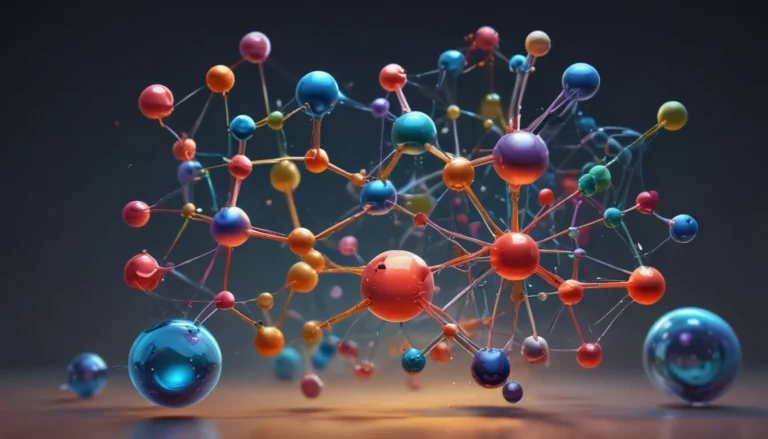A Note About Images: The images used in our articles are for illustration purposes only and may not exactly match the content. They are meant to engage readers, but the text should be relied upon for accurate information.
When it comes to delving into the depths of chemistry, one concept stands out as a cornerstone of understanding chemical interactions and molecular structures – covalent radius. This fundamental aspect of chemistry sheds light on the size of atoms when they form covalent bonds, influencing everything from bond strength to molecular shape. Join us on a journey through 19 fascinating facts about covalent radius that will broaden your knowledge and appreciation of this essential concept.
Unraveling Covalent Radius: A Closer Look
At the core of covalent radius lies the measurement of an atom’s size when it engages in bonding with other atoms. It signifies the distance between the atomic nucleus and the outermost electron shell, offering insights into the arrangement of electrons and the overall structure of molecules. Think of it as the personal space between atoms, dictating how they interact and ultimately form compounds.
Understanding the Impact on Bonding
The covalent radius isn’t just a number – it’s a key player in determining the strength and nature of chemical bonds. As the covalent radius expands, so does the bond length, impacting the stability and properties of the resulting molecules.
Distinguishing Covalent Radius from Ionic Radius
While both covalent and ionic radii focus on atomic size, they differ in their contexts. The covalent radius is typically smaller than the ionic radius, offering a unique perspective on the size of atoms in different bonding scenarios.
Exploring Periodic Trends
A journey through the periodic table unveils a fascinating trend in covalent radius. As you navigate from left to right across a period, the covalent radius of elements tends to decrease, influenced by factors like increasing nuclear charge and electron-nucleus attraction.
Embracing Group Dynamics
Within a group of elements, a different trend emerges – the covalent radius generally increases as you descend down the group. This phenomenon is driven by the addition of electron shells, elongating the distance between the nucleus and the outermost electrons.
Noble Gases: Small But Mighty
Among all elements, noble gases stand out with their petite covalent radii. Their full complement of electrons in the outer shell renders them stable and less inclined to engage in covalent bonds.
Transition Metals: Versatile Players
Transition metals introduce a twist in the covalent radius narrative, showcasing variable radii due to their ability to adopt multiple oxidation states. The radius adjusts according to the metal’s oxidation state, highlighting their adaptability in bonding scenarios.
Impact on Bond Strength
In the realm of chemistry, size matters – especially when it comes to covalent radius and bond strength. A smaller radius equates to a tighter grip on electrons by the nucleus, translating to robust bonds and enhanced sharing of electron density.
Influence on Molecular Shape
The covalent radius isn’t just about size – it also influences the shape of molecules. Variances in covalent radii can lead to diverse bond angles and molecular geometries, shaping the overall structure and properties of compounds.
Bridging Reactivity and Radius
Atoms with larger covalent radii often exhibit heightened reactivity, boasting a greater propensity to interact with other atoms and form bonds. The radius serves as a silent influencer, dictating the chemical behavior of elements.
Harmonizing Covalent and Van der Waals Radii
The covalent radius dances in tandem with the van der Waals radius – a measure of atom size in a non-bonded state. While covalent radius takes the lead in bonded scenarios, the van der Waals radius shines in non-bonded contexts.
Unveiling Periodic Table Secrets
Elements weave a tapestry of trends in the periodic table, and covalent radii are no exception. These trends unveil a roadmap for predicting element behavior in reactions and deepening our understanding of chemical phenomena.
Electronegativity Insights
A subtle dance exists between covalent radius and electronegativity – a measure of an element’s electron-attracting prowess. Smaller covalent radii often align with higher electronegativities, shaping the nature of chemical bonds and reactivity.
Measuring Covalent Radius in Action
Behind the scenes, experimental techniques like X-ray crystallography and spectroscopy play a vital role in measuring covalent radii. These methods offer a window into the atomic world, unveiling the intricacies of molecular arrangements.
Applications in Materials Science
From predicting material properties to designing innovative compounds, covalent radius serves as a guiding light in materials science and engineering. It paves the way for advancements in technology and the development of cutting-edge materials.
Bond Energy Insights
The web of bonds between atoms is intricately tied to covalent radius, with smaller radii signaling stronger bonds and higher energy requirements for breaking these connections. The radius serves as a key determinant in the stability and strength of chemical bonds.
Organic Chemistry’s Ally
In the realm of organic chemistry, covalent radii take center stage, offering crucial insights into atom sizes and shapes essential for predicting reactions and crafting novel compounds. It acts as a compass guiding chemists through the intricate world of organic synthesis.
Molecular Interactions Amplified
The covalent radius isn’t just a passive observer – it actively influences molecular interactions like hydrogen bonding, van der Waals forces, and dipole-dipole attractions. These interactions shape the behavior and properties of molecules in complex ways.
Charting the Course Forward
As we navigate through the myriad facets of covalent radius, a clearer picture emerges of its critical role in the world of chemistry. From predicting element behavior to designing new materials, the impact of covalent radius reverberates through every chemical interaction.
FAQs: Your Covalent Radius Queries Answered
- What is covalent radius?
-
Covalent radius signifies the size of an atom when it forms a covalent bond, reflecting the distance between the nucleus and the outermost electron.
-
How is covalent radius determined?
-
Experimental methods like X-ray diffraction and theoretical calculations aid in determining covalent radii, offering a glimpse into atomic dimensions.
-
What factors shape covalent radius?
-
Atomic number, electron configuration, size, and electron repulsion play pivotal roles in shaping covalent radii and influencing chemical properties.
-
How does covalent radius impact chemical reactivity?
-
Covalent radius influences bond strength, stability, and reactivity of elements, offering insights into their chemical behavior and interaction with other atoms.
-
Can covalent radius predict element behavior?
-
Absolutely! Covalent radius acts as a predictive tool, offering valuable insights into element behavior, bond formation, and reactivity in various chemical contexts.
-
Are there exceptions to covalent radius trends?
- While covalent radius trends offer valuable insights, exceptions may arise due to unique molecular structures or bonding scenarios that deviate from predicted values.
Embark on a journey of discovery through the realms of covalent radius and delve into the intricate world of chemistry. From unraveling bond strengths to predicting molecular shapes, each facet of covalent radius offers a window into the captivating wonders of the molecular universe. Join us in exploring the depths of chemistry and unlocking the secrets of covalent radius – a key to unraveling the mysteries of chemical interactions and molecular structures.






